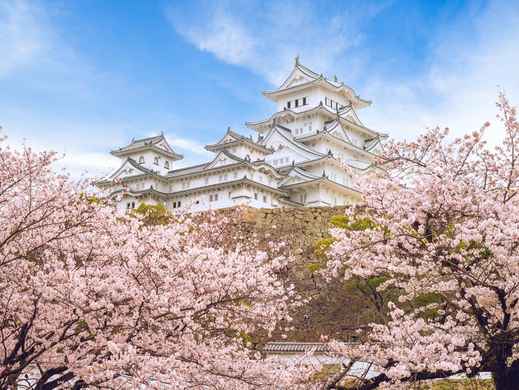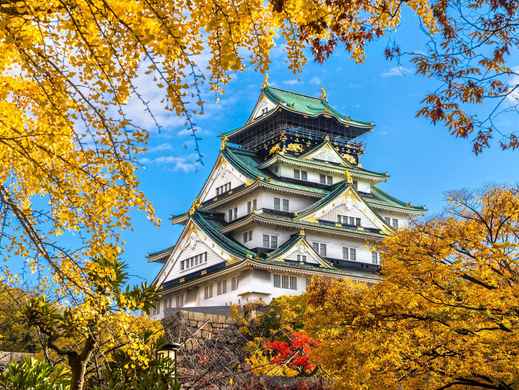


Matsue-shi
Asia
/
Japan
/
Matsue-shi
Located on the northernmost side of Shimane Prefecture and between Lake Shinji-Nakaumi, Matsue is a metropolitan city that beckons travelers to enjoy its charms. Matsue is nicknamed the "water city" due to its location between Lake Shinji, Lake Nakaumi, and the Sea of Japan. The iconic Matsue Castle is an architectural testament to the city, offering beautiful views of Lake Shinji.
As the capital of Shimane Prefecture, Matsue offers an equally beautiful cultural scene, with museums such as the Adachi Art Museum, Shimane Art Museum, and Tanabe Art Museum showcasing a stunning blend of nature and contemporary art. The serene cityscape, traditional tea houses, and captivating Noh performances make Matsue an alluring destination for those seeking an authentic Japanese experience.

Travel Tips for Matsue-shi
What you need to know before traveling here
Getting Around Matsue-shi
A guide to Matsue-shi's local transportation
Mitsue's railway line is served by Japan Railways (JR), which connects the city with other cities in Japan, including Tokyo. JR Matsue Station is a regional transportation hub, located two kilometers south of Matsue Castle.
JR train lines run through Matsue, Yasugi, Yonago, and Sakaiminato and connect to the airport, making it easy for travelers to get to and from Matsue. Travelers can enjoy scenic journeys through Shimane Prefecture, with the railway offering access to key attractions such as Matsue Castle and the Adachi Museum of Art.
Practical Tips for Matsue-shi
Things to prepare and best way to visit
Matsue is easily accessible by train, with JR West providing direct services from major cities such as Tokyo and Kyoto. If you are taking the Shinkansen from Tokyo, then you will need to take the train to Okayama, then transfer to a JR Yakumo limited express train to Matsue for a 2.5-hour ride.
Visitors can also reach Matsue by air, with Izumo Airport being the closest airport. After arriving at Izumo Airport, you will need to take a 30-minute bus ride to Matsue city center. Another airport is Yonago Airport, which is about 45 minutes away by bus from the city center.
If you want to enjoy traveling on land, then you can take a highway bus from Tokyo. The journey will take 12 hours passing through various cities in Japan. This is perfect for those who want to see the beauty of each city during the trip.
Matsue is famous for its local culinary delights, including the famous Wagashi sweets, particularly a local specialty called "Horan Soba." This unique soba noodle dish is a must-try for foodies exploring Matsue.
If you've just arrived in Matsue by train and are feeling peckish, then you can head to the ramen shops inside the station. The place is tourist-friendly and the food is unbeatable. And if you're visiting the Matsue History Museum, don't forget to try the range of drinks and handcrafted wagashi available at the Kissa Kiharu cafe inside the museum.
Matsue is known for its historical value encapsulated in the well-preserved Matsue Castle and the beauty of Lake Shinji. Matsue Castle is one of the country's 12 pristine and preserved castles built before the Edo period, a must on your Matsue itinerary!
As a city surrounded by water and nicknamed "The city of Water", you can't miss out on water activities, such as Matsue Horikawa boat tours, leisurely evening walks on the beach, sunset viewing, and other activities.
The city also has a strong cultural presence, with traditional tea ceremonies, Noh performances, and the stunning Adachi Museum of Art contributing to its appeal.
In addition, Matsue holds many myths and legends relating to Japanese deities. It's no wonder that there are many shrines in the city, one of which is the Izumo Taisha Grand Shrine, believed to be a gathering place for the gods.
From learning about history, literature and cultural exchange, to relaxing by the lake, you'll find plenty of fun activities in Matsue.
In Matsue, visitors can explore the iconic Matsue Castle, stroll along the picturesque shores of Lake Shinji, experience a traditional tea ceremony, and immerse themselves in the tranquil landscapes of the Adachi Museum of Art. Additionally, discovering the samurai residences in the historic districts offers a glimpse into the city's rich heritage.
Take a visit to Sada Jinja, a Shinto shrine and sanctuary surrounded by lush greenery. It provides a quiet space to contemplate and appreciate traditional Japanese architecture.
Lastly, the Lafcadio Hearn Memorial Museum is a must-visit if you want to learn about the life of Lafcadio Hearn, a Western author of Japanese culture, and see his devotion to Japan reflected in his works.
Creating an itinerary in Matsue involves exploring the city's rich culture and history, as well as its natural scenery. Start your trip with a visit to Matsue Castle and see the splendor and power of this 16th-century castle. Around the castle, there are plenty of activities to do, such as sitting in the garden and taking in the beauty of the castle from afar.
Then, head to the Adachi Museum of Art to enjoy the fusion of nature and contemporary art. Once you're satisfied, you can explore the city by taking the Ichibata Electric Railway to explore the charming local spots. End your day by savoring local flavors, including eating the famous Horan Soba noodles and enjoying the sunset at Lake Shinji, for a complete Matsue experience.

Explore Matsue-shi
Create your itinerary with our top picks below

Travel Tips for Matsue-shi

Explore Matsue-shi
More Destination Near Matsue-shi























 Instagram
Instagram TikTok
TikTok Youtube
Youtube
